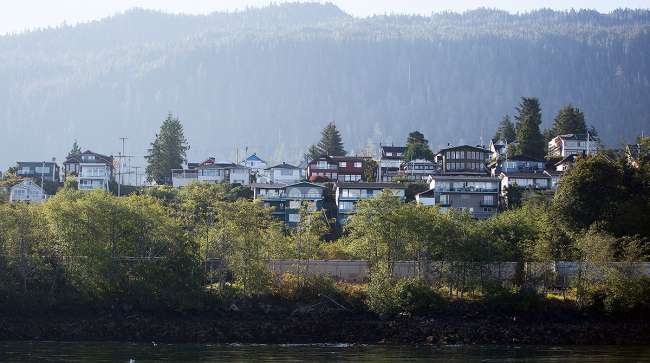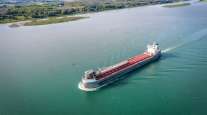Port Prince Rupert Thrives Despite Global Tariff Turmoil

Prince Rupert is hardly the place one would expect to find an international gateway that’s weathering the Trump trade storm better than any other Pacific port in North America.
There’s just one bakery in the town of 12,000 people tucked away in a misty corner of western Canada. The local Walmart outlet is affectionately known as “Smallmart.” Shuttered storefronts on its main street are obstinate reminders of the collapse of its pulp and fishing industries more than a decade ago.
Yet this rainy outpost in British Columbia is the continent’s fastest growing port for trans-Pacific trade. In the first half of 2018, Prince Rupert’s container volumes surged by 19% from the same period last year, more than any other major gateway for Asian trade in the United States, Canada or Mexico.
RELATED: In Times of Trade War, Companies Get Creative to Avoid Tariffs
“I would rather call these hiccups,” Maksim Mihic, head of Canada for Dubai-based marine operator DP World Ltd., said of the Trump trade war. His company paid C$580 million ($442 million) three years ago to buy Fairview, Prince Rupert’s upstart container terminal that has been snatching market share from rival ports such as Seattle-Tacoma and Los Angeles. “Whenever you have a trade barrier, there’s opportunity — the market will find a way.”
Shippers have discovered Prince Rupert often is the quickest, most reliable, and cheapest route to get everything from Nike sneakers, Microsoft computers and John Deere tractor parts from Asian factories into the U.S. heartland. Empty containers on the return trip, in turn, create an opportunity for Canadian lumber and grain producers to expand exports to the world’s fastest-growing markets. The town’s proximity to Asia is a built-in advantage — up to 58 hours closer by sea than any other North American gateway — which for ships traversing the route can mean about one additional round-trip voyage a year.
Port Surges
In 2017, Prince Rupert’s portwide volumes surged 28% to a record 24 million tons. DP World’s C$200 million expansion readied Fairview to accept the largest vessels at sea, which increasingly are favored by shippers seeking to load more containers to reduce costs. Within months, the facility welcomed the largest ship to ever dock at a Canadian port — the Himalayas which, if vertical, would tower over Canada’s tallest building.
“We expect it’ll be another record year,” port CEO Shaun Stevenson said. “We represent that opportunity for industries to pivot and look at the Asia-Pacific region.”
At the 24-hour container terminal, massive cranes soaring as high as a 20-story building pluck steel boxes off a ship onto a line of trucks below. Nearby, railcars wait on track laid directly on the dock by Canadian National Railway Co., whose 20,000-mile network connects the Pacific Coast, the Atlantic and the Gulf of Mexico. The ship-truck-rail transfer is so seamless — unhampered by the urban congestion plaguing larger rivals such as Vancouver — that two trains of goods can be on their way before a vessel is fully unloaded.
Chicago Route
From Prince Rupert, it’s a 90-hour shot to Chicago mostly on a natural downgrade through Canada’s sparsely populated interior, meaning railcars rattle their way to the distribution heartlands of America faster than over any other competing route. So precise and consistent is the path — Microsoft Corp. said it can track arrivals almost to the minute — that the technology giant at times has shipped Chinese imports bound for California via Chicago rather than through a California port. In the other direction, exports of containers stuffed with grains — a deviation from the traditional bulk method of pouring grains directly into ships at specialized terminals — are booming.
“The advantage is that you can deliver the container to every corner of the market in Asia,” Mihic said. Instead of committing to a shipload of pulses, an Indian buyer can order 20 tons of lentils for distribution to local mom-and-pop shops, he said. “That is the advantage for Canadian exporters — that’s the untouched territory for us. It’s much more flexible.”
Not Convinced
Still, some aren’t convinced that President Donald Trump’s trade battles with China, Europe and Canada won’t hamper port shipments at some point. Port officials across the region “don’t want to think that tariffs will expand beyond those already in place and that even those tariffs will be unwound fairly soon,” said Jock O’Connell, an international trade consultant and adviser to Los Angeles-based Beacon Economics. “I’m not that optimistic.”
“Any port that serves as a major conduit for the supply chains that link the U.S. and China ought to be concerned about declines in the volume of trade — and the Port of Prince Rupert fits that description,” he said.
In Prince Rupert, signs of apprehension are hard to find.
In June — just days after Trump first threatened tariffs on $200 billion worth of Chinese imports after earlier extending steel tariffs to Canada and Mexico — DP World committed to boosting the terminal’s capacity by an additional third by 2022. Meanwhile, CN Rail is investing C$340 million in 2018 to support that growth with more capacity.
Prince Rupert’s prominence has been a long time coming. Its extraordinary positioning was spotted in the early 1900s, but its ambitions were cut short when its principal backer — Charles Melville Hays, the railroad tycoon who laid the groundwork for the critical link underpinning it today — died aboard the Titanic in 1912.
“The beginning of our town was a failed dream,” said Mayor Lee Brain, who is getting calls daily from companies seeking to set up logistics, container-stuffing and warehouse businesses near the port. “It took a hundred years, but now we are the Asia-Pacific gateway for intercontinental trade.”
The town’s future now may now be tied to a metal container. While tariffs and commodity cycles can strike grain, coal and oil terminals, global container traffic is surging as shippers seek to cram more products into the giant, Lego-like cubes that make freight easier and cheaper to handle. In fact, Trump risk aside, containerization likely has been a bigger driver of globalization than free trade in the post-World War II era, boosting trade by as much as 1,240% , according to one study in the “Journal of International Economics.”
Peak Container
“ ‘Peak container’ isn’t on the horizon,” a McKinsey & Co. report declared last October, saying container traffic was likely to grow as long as the global economy keeps growing. “Indeed, the flexibility of the container trade makes it resilient: One product may go out of fashion, but another will come along to fill the box.”
Meanwhile, signs of prosperity are cropping up in Prince Rupert. The town recently saw its first near-C$1 million home — a 4,960-square-foot residence perched on a bluff overlooking one of the world’s deepest natural harbors, according to Nikki Morse, a local real estate agent. The mayor said so many residents are renovating their homes that the municipal landfill is running out of space.
“There are more Audis, BMWs and Mercedes driving around than in probably 30 years,” Stevenson said.




